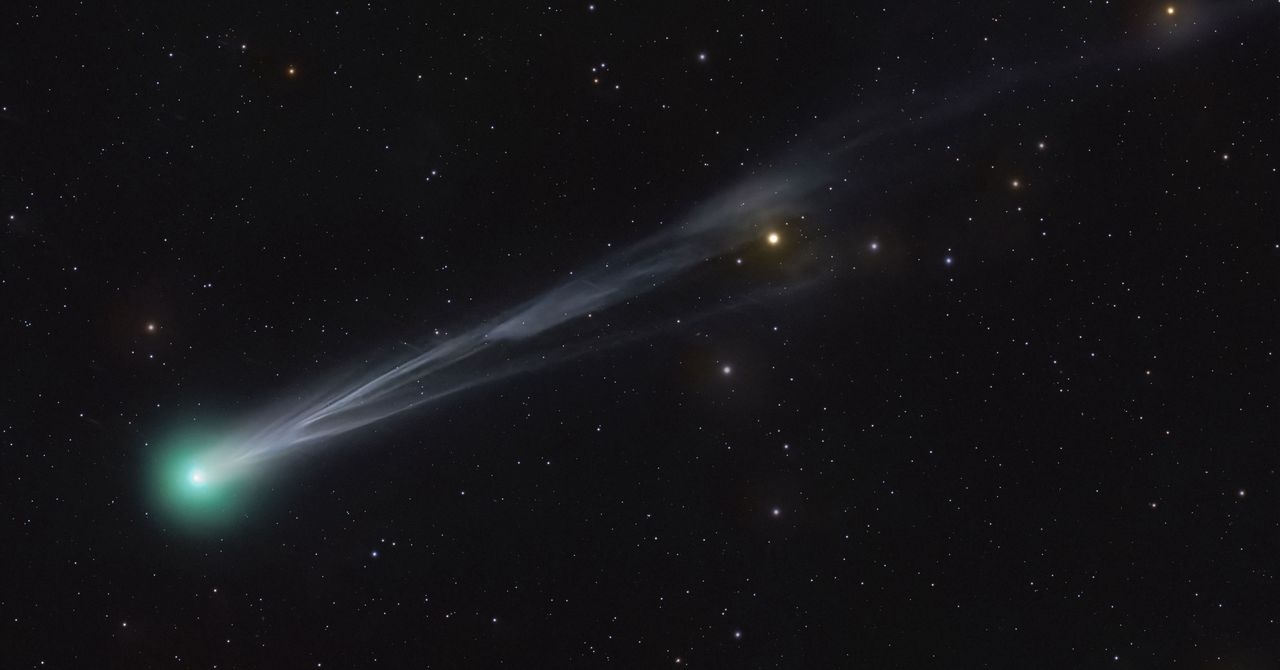How to See Comet Lemmon This October

It was early January 2025 when a faint light spot was observed at the Mt. Lemmon Observatory in Arizona. Follow-up observations revealed that the object was a comet visiting from the outer edge of the solar system, and it was named Comet Lemmon (C/2025 A6). Its “period”—the time it takes to complete its lengthy orbit of the sun—is about 1,350 years.
At first, the comet was so faint that it could only be seen with specialized equipment. But it has brightened rapidly as the months have passed, and by the time fall arrived, it was bright enough to be viewed with binoculars. It will now get brighter still, as it gets closer to both the Earth and the sun, and may even become visible with the naked eye.
According to NASA, Comet Lemmon will be closest to Earth around October 21, 2025, passing at a distance of about 0.60 astronomical units, or au (1 au is the distance between Earth and the sun). The comet is then predicted to reach perihelion—the point at which it is closest to the sun—on November 8. Around the time the comet reaches perihelion, it will likely reach its maximum brightness, and may be visible to the naked eye if conditions are favorable in dark skies.
The comet’s tail will also be at its longest extension around the point of perihelion. Tails form on comets when solar radiation heats up frozen ice and gases contained in the comet’s nucleus, causing them to sublimate—transform from solid into a gas—with the radiation then causing some of that material to be emitted out from the comet in a telltale streak. The stronger the radiation, the greater the size of this effect, and so comets’ tails grow as they get closer to stars and shrink again when they move away.
Comet Lemmon is notable for its greenish tint. This is caused by the gas cloud that surrounds the comet’s nucleus, known as its “coma,” with the color being created by diatomic carbon (molecules of two carbon atoms) interacting with sunlight.

Comet Lemmon (C/2025 A6) photographed in Slovenia in early October.
Photograph: Uroš FinkAs of early October, Comet Lemmon can be found slightly below the handle in the Big Dipper (or the Plough, as it's known in the UK), which forms part of the Ursa Major constellation. If you look up at the northern sky, you will be able to trace its path. In the northern hemisphere, it is predicted to appear in the northwestern-to-western sky after sunset from mid-October onward. It will be at a low altitude above the horizon and is expected to emit a faint glow in the twilight just after the sun has set.
The best time to observe the comet is about a week before and after its closest approach. In November, the comet will cross the celestial equator and become visible from the southern hemisphere.
Binoculars or small telescopes are best for observing it, but if you choose a location with little light pollution, you may be able to catch it with the naked eye. If you look up at the sky just after sunset when it is still a little bright, you may be able to see it. It you are struggling to find the comet, use a star map application on your smartphone or planetarium software to help you pinpoint its location.

Comet Lemmon photographed in Texas from September 25 to October 4 (images get more recent from left to right). You can see the comet’s tail growing as it gets closer to the sun.
Photograph: Victor Sabet and Julien De WinterComets are “fossils” of ice and dust from 4.6 billion years ago, when the solar system formed. Their nuclei retain materials that were frozen in a region far from the sun in the early stages of planet formation. Changes in composition and activity exhibited by Comet Lemmon could thus provide important clues to the environment of the outer solar system. In general, researchers try to observe comets using spectroscopic instruments to analyze water and organic molecules they contain. The act of looking up at the sky is also an act of looking into the past.
Comet Lemmon’s journey across the night sky is the culmination of a more than 1,000-year voyage through space, as it travels around the sun and out again into the far reaches of the solar system. What humanity is witnessing now won’t be seen again for another millennium.
The comet will eventually disappear from sight, with the sun behind it, before losing its light and returning to the darkness of space. So in the night sky of October, when the air is clear, take the chance if you can to witness a traveler carrying 4.6 billion years of memories.
This story originally appeared on WIRED Japan and has been translated from Japanese.
wired





